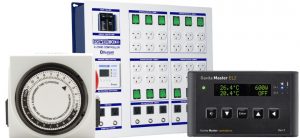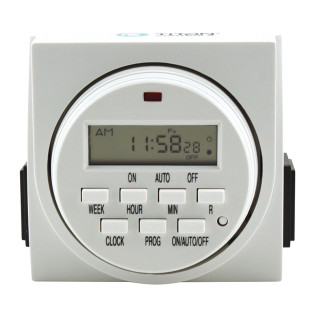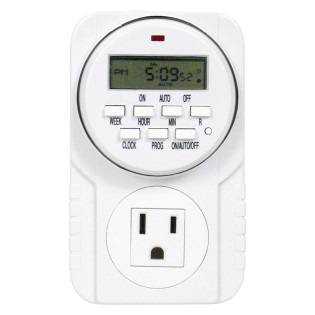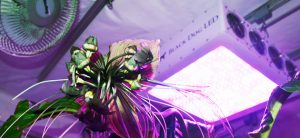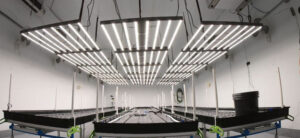
When it comes to growing indoors, you’ll obviously need a grow light. But in order to make that light work as intended, you’ll need a grow light timer or controller to set up your day and night schedules.
Some people look at timers and controllers as an accessory, but we consider these a necessity.
We’ll explain why that is, and also breakdown the different types of timers and controllers, along with some features to look for when shopping for yours.
Why You Need a Grow Light Timer
If you want to grow inside, you need to make sure your plants get the perfect amount of light. This varies from plant variety to plant variety.
But for plants that have a veg and flower cycle, they have different lighting needs during each stage of growth.
For example, during vegetative growth when you’re trying to promote leafy, branching growth, plants need at least 18 hours of light a day, followed by 6 hours of darkness.
Some growers will opt for a 24 hour light schedule during veg, but many growers see better results giving their plants a sleeping period.

When it comes time to flower, plants need their lighting reduced to simulate the changing of seasons, like with outdoor growing. At this point, they do best with a 12/12 lighting cycle.
So, unless you plan on living in the grow room and manually turning on and off your lights at the same exact time every day, you can see why a grow light timer is a necessity.
These essentially free you from the grow room and automate the lighting aspect of your grow.
What are the different types of lighting timers and controllers?
Just about any timer will get the job done, but some of them these days have really cool features. Let’s get into the different types of grow light timers.
Single Outlet Timers vs. Dual Outlet Timers
Breaking down the difference between single and dual outlet timers is pretty simple. While a single outlet timer can accommodate one light, a dual outlet will be able to handle two.
Most of these timers can be used with all kinds of lights, as well as with additional equipment like CO2 generators and fans.
The main thing to be aware of is that, even if you are using a dual outlet timer, you need to pay attention to the rated amperage on the outlet.
As a general rule of thumb, most will be rated to around 15 amps, but this can vary - so make sure you check.
Single outlet and dual outlet timers usually work exactly the same. In most cases, you will program one setting to be used for both lights. This usually follows a 24-hour schedule.
Both single outlet and dual outlet timers are easy to use. Some, like the Titan Controls Apollo 8, come with fifteen-minute “trippers” so that you can set timing schedules to meet the unique requirements of your plants.
Digital vs. Mechanical Grow Light Timers
Timers are either digitial or mechanical, which refers to how you program them.
Mechanical timers, sometimes referred to as analog timers, usually include dials or switches that let you adjust the time.
These are usually broken down into a 24-hour cycle with 15 minute on/off options. They're really all a small scale hobbyist with a few plants needs.
They’re easy to set up and use - all you’ll have to do is crank the dial to the hours you want it to set.
But, most growers use digital timers because they have LCD readouts and tons of built-in functions.
They are easy to use, and you can have different schedules for different days of the week. And these days, they are really cost-effective, with some starting under $20.
Many digital timers also function during a power outage (manual timers will need to be reset). This is because they come with battery back-up features that will save your settings and keep chugging along when the power goes out.
Both mechanical and digital timers can be purchased with dual- or single-outlet capabilities.
Large Multi-Zone Controllers
There are also larger multi-zone controllers that work well for growers managing large grow rooms. These come in several forms.
Some look just like power strips and can be used to run other types of equipment, too. You can control CO2 equipment, fans and other equipment that you want on the same cycle as your grow lighting.
Some don’t include the ability to set a timer for all of the included outlets. You may only be able to set a timer for four or five of the included plugs. You’ll usually have to set everything to the same preset schedule, too.
The benefit of this kind of controller is that it is safer. These strips can help prevent overloads as they shut off automatically when too many devices are running.
They can usually protect outlets up to 1000 joules or more. Again, you’ll want to pay attention to the amperage and avoid overloading it.
These usually have digital display screens and can be programmed just like any other digital timer.
But, some of these come with cool features, such as Bluetooth compatibility, so you can monitor your grow lighting remotely.
These multi-zone controllers are essential for those with large grow rooms and multiple growing champers, such as in a perpetual harvest.
Features To Look For On Your Timer
There are all kinds of features to look for on your timer. These aren't mandatory for everyone, but some growers may need these.
Though not a mandatory feature in a grow light timer, a trigger cord can be quite beneficial. Having multiple trigger cords will allow you to stagger your light timing or to have two different timing schedules.
Some controllers also have high-temp shut off. This will protect your lights and your grow room environment when temperatures exceed a certain point.
There are also timers and controllers with photocell, which is great for those with CO2 and fans in there room. It gets them on the same cycle as your grow lights, as these pieces of equipment generally need to be used together.
Here are some other features to look for:





